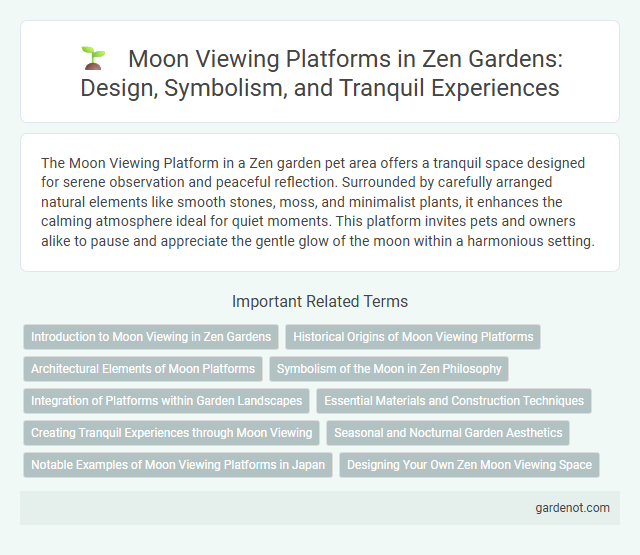The Moon Viewing Platform in a Zen garden pet area offers a tranquil space designed for serene observation and peaceful reflection. Surrounded by carefully arranged natural elements like smooth stones, moss, and minimalist plants, it enhances the calming atmosphere ideal for quiet moments. This platform invites pets and owners alike to pause and appreciate the gentle glow of the moon within a harmonious setting.
Introduction to Moon Viewing in Zen Gardens
Moon viewing platforms in Zen gardens offer a serene space designed to enhance the appreciation of the moon's beauty within a carefully crafted natural setting. These platforms integrate elements such as raked gravel, stone lanterns, and strategically placed rocks to harmonize with lunar light and seasonal changes. Rooted in Japanese cultural traditions, moon viewing is a meditative practice that fosters reflection, tranquility, and connection to nature's cyclical rhythms.
Historical Origins of Moon Viewing Platforms
Moon viewing platforms in Zen gardens trace their origins to Heian-period Japan, where aristocrats constructed elevated structures known as tsukimi-dai to appreciate the autumn moon. These platforms became essential elements in traditional garden design, symbolizing harmony between nature and human artistry. The integration of tsukimi-dai reflects ancient Japanese aesthetics and seasonal reverence pivotal to Zen garden philosophy.
Architectural Elements of Moon Platforms
Moon viewing platforms in Zen gardens feature minimalist architectural elements such as natural stone slabs, tatami-style wooden decking, and low, unobtrusive railings designed to harmonize with surrounding landscapes. These platforms often incorporate elevated bases to frame unobstructed views of the moon, emphasizing the connection between built structures and nature. Subtle use of lighting and shadow enhances the contemplative atmosphere, reinforcing traditional Japanese aesthetics in their design.
Symbolism of the Moon in Zen Philosophy
The Moon viewing platform in a Zen garden embodies the Zen philosophy of impermanence and enlightenment by symbolizing the moon's constant yet ever-changing reflection on water. This platform invites contemplative observation, highlighting the fleeting nature of life and the importance of mindfulness in the present moment. The moon serves as a metaphor for inner clarity and awakening, central to Zen teachings.
Integration of Platforms within Garden Landscapes
The moon viewing platform in a Zen garden seamlessly integrates with the surrounding landscape by utilizing natural materials such as weathered wood and stone that echo the garden's textures. Its strategic placement on elevated terrain maximizes unobstructed views of the lunar surface while harmonizing with minimalist design principles. This integration enhances the contemplative atmosphere and invites reflection under the night sky, reinforcing the Zen garden's purpose of serene meditation.
Essential Materials and Construction Techniques
The Moon viewing platform in a Zen garden is crafted using natural materials such as weathered wood, smooth stone, and bamboo to harmonize with the surrounding landscape. Traditional Japanese joinery techniques, including mortise and tenon joints, ensure durability without the use of nails, preserving aesthetic simplicity. The platform's elevation and placement are carefully calculated to frame moonlight reflections while maintaining structural stability.
Creating Tranquil Experiences through Moon Viewing
The Moon Viewing platform in a Zen garden serves as a dedicated space for quiet contemplation under the night sky, enhancing the serene atmosphere. It aligns with traditional Japanese aesthetics, allowing visitors to connect deeply with nature and the lunar phases. This carefully designed area promotes peaceful reflection, fostering mindfulness and inner calm through the art of moon appreciation.
Seasonal and Nocturnal Garden Aesthetics
The Moon viewing platform in a Zen garden emphasizes seasonal changes and nocturnal beauty, offering a tranquil space for appreciating the shifting hues of autumn leaves and the delicate glow of moonlight on raked gravel. Subtle lighting enhances the contrast between shadow and light, highlighting lanterns, stone lanterns (toro), and carefully pruned foliage during nighttime hours. This design fosters a contemplative atmosphere that aligns with traditional Japanese aesthetics, encouraging meditation and connection with nature's cyclical rhythms.
Notable Examples of Moon Viewing Platforms in Japan
The moon viewing platform at Ritsurin Garden in Takamatsu is renowned for its panoramic views of the night sky framed by carefully pruned pine trees and seasonal blossoms. Kodaiji Temple in Kyoto features a historic moon viewing platform designed during the Momoyama period, integrating traditional architecture with serene landscaping to enhance lunar appreciation. Another iconic location is the moon viewing pavilion at Ginkakuji, also in Kyoto, where visitors can experience a blend of Zen aesthetics and poetic ambiance under the moonlight.
Designing Your Own Zen Moon Viewing Space
Designing your own Zen Moon Viewing space involves integrating natural elements like smooth stones, minimalist wooden benches, and soft ambient lighting to create a serene atmosphere. Incorporate a low, circular platform that frames the moon while allowing comfortable seating for meditation or quiet reflection. Use subtle textures and carefully placed plants to enhance the contemplative mood, ensuring harmony between the viewer and the night sky.
Moon viewing platform Infographic

 gardenot.com
gardenot.com